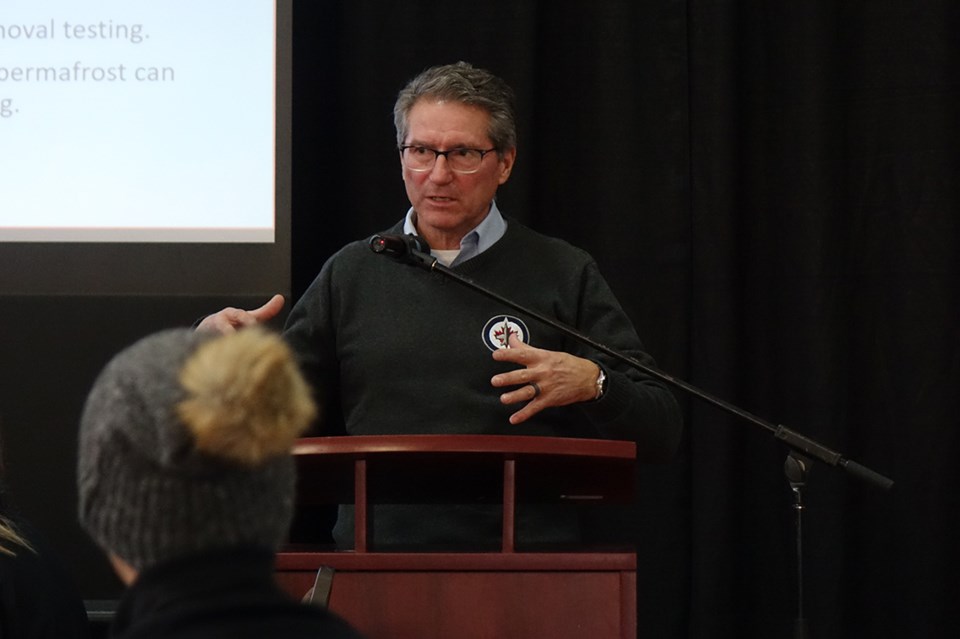The winter weather testing industry in Thompson is undergoing a significant change this week, with the airport finalizing its purchase of Ford’s testing facility, becoming not only the site of assets for testers but also an access provider.
Curtis Ross, CEO of the Thompson Regional Airport Authority, which runs the airport north of the city, says the purchase of Ford’s assets will be completed Dec. 1.
Ross spoke about the airport authority’s entry into the winter weather testing business with the Thompson Citizen and conference attendees at Sub Zero North’s winter weather testing conference, which began in Winnipeg Nov. 15 and wrapped up with tours and presentations in Thompson on Nov. 17. The airport CEO is familiar with the business, having worked for many years in his capacity as an independent business owner with companies such as Honda.
“The airport’s into the winter weather testing business all of a sudden in a big way,” Ross said.
With the long-awaited new airport terminal expected to actually begin the construction process with the driving of piles in the spring, there is potential for the amount of facilities available to winter weather testers to increase substantially from what the former Ford facility has, which includes a cold chamber where different sections can be cooled to different temperatures as well as meeting rooms. Once the new airport is open, the old terminal’s parking lots will be available and eventually the current airport access road will be cut off from the highway once a road to the new terminal is built, which will create a closed loop for testers to use without encountering other traffic.
“They’re all going to be marketed as part of the winter weather testing and climate change and things like that that people can use for testing,” Ross said.
Physical facilities are needed to help regrow and eventually expand the local winter weather testing industry, Ross said, but one of Thompson’s real advantages is providing a place for companies to test their products in real-world conditions.
‘We’ll test it up here in real-time conditions,” said Ross, noting that winter weather testers can even make use of the airport’s runways between approximately 11:30 p.m. and 5 a.m., seven days a week.
The city’s location in a remote and sparsely populated region is also an advantage, conference attendees heard from virtual presenter Alec Wilson of Spexi Geospatial, a company that provides software to help capture and use imagery from drones and came up to Thompson last spring, performing tasks such as helping investigate how the Hudson Bay Railway could use drones to monitor the condition of its tracks between The Pas and Churchill.
“It’s relatively unpopulated,” said Wilson of the Thompson area. “This is really good for testing because it provides a safe environment. There’s not a ton of air traffic out there. For drones this is very useful, not to worry as much about safety, and we don’t really have to worry about the safety of people on the ground.”
Despite being eight hours away from the nearest big cities, Thompson is not as far away from them as other testing centres, like Yellowknife or Fairbanks, Alaska, said Ross, which makes testing here logistically more sensible.
“To get a vehicle from Detroit, Michigan all the way up to Anchorage, Alaska is a little bit more difficult,” said Ross. “We can get that vehicle from point A to point B to Point C. You can see the economics of it makes so much more sense than trying to get to Fairbanks, Alaska.”
More than anything, Thompson’s biggest selling feature is its temperatures, Ross said. But that might not mean exactly what you think — for example, that the number of really cold days is the most important factor.
Jordan Ilot of the GLACIER jet engine testing facility south of Thompson just off Highway 6 told the conference that that facility, for the most part, doesn’t need to test engine icing below about -23 degrees Celsius for safety agencies in the United States or -27 for some in Europe. However, with tests at temperatures up to about -3 degrees also required, the sheer number of days below zero is important.
“We’re not looking for a large number of -40 days, we’re looking for a good spread,” he said. “Thompson gives us some variability, which we need, and a good early start to the testing and a fairly long extended tail in the spring.”
Lindsay Moore of Airmarket, a company focused on developing ways to track the number of drones in a particular section of airspace that was working with Spexi last spring, said that climate change could mean more companies in Canada doing work further north than they have in the past, and also increase efforts by the government to ensure Canada’s Arctic sovereignty in its very sparsely inhabited near north and far north.
“I think companies as a whole have to be able to understand what does that mean to them.”
As Wilson and his counterparts at Spexi learned last spring, it’s often people who have the hardest time standing up to harsh winter conditions, while equipment can perform better than expected, even when it isn’t sub-zero temperature rated, possibly because it hasn’t been tested to determine its ability to withstand the cold.
Much of the equipment they were using, he said, was recommended only for operation in temperatures down to zero degrees Celsius, or perhaps -10.
“Our software handled it extremely well,” Wilson said. “The hardware that was provided by the government and by us really exceeded expectations in severely cold temperatures.”
From the airport’s perspective, becoming the owner of winter weather testing facilities is not only good for the local economy, but for the airport’s viability as well.
“COVID taught us a lot of things,” he said. “One is diversify.”
Ross also said he is impressed with the growing number of partnerships connected to winter weather testing that are being established.
“The networking in a few months that’s happened and the connections that are being made, we’ve got Transport, Canada, the National Research Council, all those players are wanting to embed themselves in some way, shape or form and test here,” he said.
In the future, Thompson could be a source not only of suitable winter weather testing temperatures and facilities, but even of expertise, Ross believes.
“We’re moving from just supplying people assets to test to maybe being involved in the testing industry and having technical people employed in Thompson and working on testing and sending the data,” he said.




